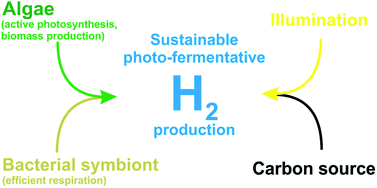Bacterial symbionts enhance photo-fermentative hydrogen evolution of Chlamydomonas algae
Abstract
The green algae Chlamydomonas sp. MACC-549 and Chlamydomonas reinhardtii cc124 were investigated for their hydrogen-evolution capability in mixed algal–bacterial cultures. Stable bacterial contaminations were identified during the cultivation of Chlamydomonas sp. 549. The bacterial symbionts belonged to various genera, mostly Brevundimonas, Rhodococcus, and Leifsonia, each of which enhanced the algal hydrogen production. This phenomenon was not limited to natural associations. Increased algal hydrogen evolution was achieved by simple artificial algal–bacterial communities as well. Algal–bacterial cocultures were designed and tested in hydrogen evolution experiments. The highest hydrogen yields were obtained when hydrogenase-deficient Escherichia coli was used as a symbiotic bacterium (Chlamydomonas sp. 549 generated 1196.06 ± 4.42 μL H2 L−1, while C. reinhardtii cc124 produced 5800.54 ± 65.73 μL H2 L−1). The results showed that oxygen elimination is the most crucial factor for algal hydrogen production and that efficient bacterial respiration is essential for the activation of algal Fe-hydrogenase. The algae-based hydrogen evolution method described represents a novel combination of fermentative and photolytic hydrogen generation processes. Active photosynthesis was maintained during the entire hydrogen evolution process, which contributes to the sustainability of hydrogen production.


 Please wait while we load your content...
Please wait while we load your content...